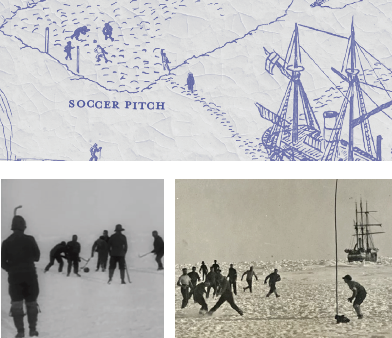Shackleton & History: How We Built a Puzzle Adventure Closer to the Truth
When we set out to create the Shackleton series at Escape Mail, we made one central decision: we wanted to tell an inspiring true story that stuck remarkably close to the facts of real history; perhaps closer than any other game of its kind.

Over six episodes, we’ve taken you through the journey — the preparation, the ice, the trials, the war-time pressures, and all the moments of human struggle and camaraderie. Below is a look at how each episode reflects historical truth, where we’ve taken careful liberties, and why those choices serve both story and puzzle.
Sources & What Informed Our Choices
We drew deeply from historical texts:
-
Endurance by Alfred Lansing (1959)
-
South by Ernest Shackleton
-
Journals and archived documents (e.g. photographs, maps, crew journals)
-
Visual and material culture of the early 20th-century polar exploration (attire, ship‐building, gear, rations)
When historical records were sparse or ambiguous, we made creative decisions. We never twisted the core facts—dates, major events, outcomes remain true. But to build puzzles and visuals that work in a game context, we sometimes had to imagine settings, dialogue, or layout.
Why Accuracy Matters (to Us & to You)

-
Immersion: When the “story pages” follow real dates, real quotes, and real events, you aren’t just solving puzzles—you’re living history.
-
Respect: These were real people, with real struggles. By staying as accurate as possible, we honor their endurance, leadership, and courage.
-
Engagement: Odd facts, real hardships, dog names, survival tactics—these details draw you in. They give you texture, atmosphere, emotional stakes.
-
Trust: We want you confident that when you play, you’re not getting “pseudo-history” but something built on research and respect.
Light Fiction Where It Helps

We use fictional elements in specific places:
-
Puzzle pages: For example, some interactions, dialogues, or puzzles are invented or adjusted to make the gameplay work.
-
Visual/graphic details: Some maps, depictions of rooms, or gear might not be 100% documented. We sometimes adjust for clarity, storytelling, or visual impact.
-
Names and roles: We sometimes modify or omit when sources disagree, or when clarity is more important than absolute precision.

Let's Break it Down Episode by Episode:
| Episode | What’s historically accurate | Where we stretched (just a bit) | Why we did it |
|---|---|---|---|
| Episode 1 – The Journey Begins | The expedition name, dates, key events, Shackleton’s selection strategy, the ship Endurance, the motto “Fortitudine Vincimus.” | Some fictional elements (puzzle inserts), minor map errors (e.g. “Ross Shelf Ice”), a fictionalized stowaway page. | To create solvable puzzles while preserving historical immersion. |
| Episode 2 – Trials of Endurance | Real quotes from journals; ship trapped in ice; crew morale through sled races, games, and hunting; Mid-Winter’s Day celebration. | Engine room layout is partially speculative; altered dog names; dramatization of weather effects. | To visually simplify, keep puzzles flowing, and preserve engagement. |
| Episode 3 – Waiting on Ice | Shackleton’s leadership choices; building shelters; rationing food; journal entries from crew like Orde-Lees. | Some dialogue and diary excerpts are fictionalized; maps simplified for puzzles; order of small events compressed. | To keep the narrative tight and align with puzzle pacing. |
| Episode 4 – Five Nights of Fury | The lifeboat voyage in the James Caird; the true hardships of navigating freezing waters; Frank Worsley’s precise celestial navigation. | The actual routes shortened; navigation challenges turned into solvable puzzles; crew interactions lightly dramatized. | To make navigation logic playable while highlighting real endurance feats. |
| Episode 5 – An Open Boat Voyage | The real landing on South Georgia; the treacherous trek across the Drake Passage; exhaustion, frostbite, and hunger. | Topographical details simplified; certain exchanges between Shackleton, Crean, and Worsley dramatized; timings condensed. | To make geography manageable and transform terrain into puzzles. |
| Episode 6 – A Daring Rescue | Shackleton’s successful return to Elephant Island; the rescue of his men without a single death; the sheer relief recorded in journals. | Some letters and telegrams paraphrased; pacing of rescue events streamlined; puzzle artifacts invented. | To deliver a satisfying conclusion that doubles as a playable finale. |

The Payoff: What You Get When History Meets Puzzle
When you play Shackleton via Escape Mail, you gain more than a game. You get:
-
A narrative that feels real, with tension, with stakes, with filigree of human detail (nicknames, dog names, storms, shortages).
-
Puzzles grounded in context—not just arbitrary riddles, but ones that make sense within the icy, cramped, moving world of the Endurance.
-
A sense of accomplishment not just for solving, but for having walked the terrain of history, however virtually.

And as an added bonus, every episode details EXTENSIVELY the exact similarities and differences between real history and the game you play. We call these our Historicity pages and you can see an example of Episode 1 here.
Solve the Series at Home
If you’ve ever wondered what it feels like to endure the Antarctic cold, to test leadership and courage, to solve riddles under pressure—Shackleton isn’t just a story. It’s an experience.
Check out Escape Mail’s Shackleton series now. Start with Episode 1: The Journey Begins for less than $25 and see for yourself how history, puzzle, and storytelling combine. And if you like what you experience, share it with friends who love mystery, true stories, or just a really good puzzle.







Leave a comment